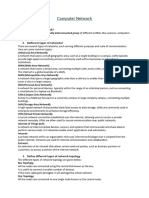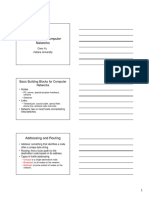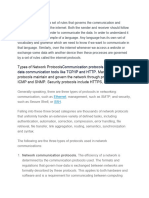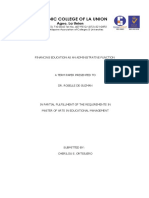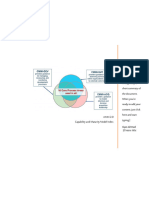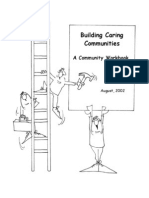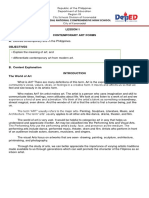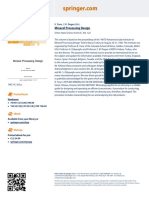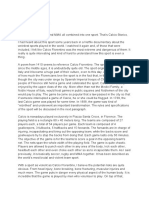RESTRICTED
PROTOCOLS
AIM
1. To acquaint the class about Protocols.
PREVIEW
2. Topic will be covered as Protocol.
3. How to connect two Networks?
To connect two different Network a Router is needed. Because we can
communicate many pc in same Network but we can’t connect different Network without
Router.
(a) Configure the Router.
(b) Give two different Network IP on both port of Router.
(c) Connect two group of PCs on both port by help of switch.
(d) Give two different Network IPs on both group of PC.
(e) Give default gateway on all PCs as per their respective port IP of Router.
(f) Now communication will be est between two Network.
4. Commands to configure Router:-
Enable
Configure terminal
Interface Fa0/0
IP Address 192.168.1.1 255.255.255.0
No shutdown
Same as this on other port but different Network IP.
RESTRICTED
� RESTRICTED
5.Transport Control Protocol (TCP): Discussed in Transport Layer.
6.User datagram Protocol (UDP): Discussed in Transport Layer.
7.Address Resolution Protocol (ARP). This allow the source device to send a
specific mac address without having to broadcast all messages. A table with these
mapping is stored for each network interface card in the sys. C:/>arp -a
8.Reverse Address Resolution Protocol (RARAP). The opposite of the ARP -
provides the IP address for a device whose mac address is known.
RESTRICTED
� RESTRICTED
9. Trivial File Transfer Protocol. Work with the UDP to transfer files across the
internet requires an acknowledgement of receipt of each packet before the next is
transmitted.
10. Internet Control Message Protocol (ICMP). ICMP is implemented on all
TCP/IP networks providing messaging that can help with troubleshooting, including
(a) Destination unreachable
(b) Time exceeded.
(c) Redirect.
(d) Ping command work on ICMP protocol.
11. Internet Group Management Protocol (IGMP). IGMP is used by hosts to join
or leave a multicast host group.
12. Hypertext Transfer Protocol. Used to access html files on the internet provide
only two services (requests from client and response from server) http provide the
encryption and security.
13. Dynamic Host Configuration Protocol (DHCP). Dynamically provide IP
addresses to devices on the network. DHCP server provide the address from the pool
either for a limited time or the duration of the device’s use of the network.
14. Simple Network Management Protocol. Allows the configuration, monitoring
and management of network resources and devices.
15. FTP (FILE TRANSFER PROTOCOL)
(a) Application. Allow transfer of files between devices.
(b) Transfer file to/from remote host.
(c) Client/Server model.
(i) Client: side that initiates transfer (either to/from remote).
RESTRICTED
� RESTRICTED
(ii) Server: remote host.
(d) FTP: RFC 959.
(e) FTP server: Port 21.
16. Electronic Mail
Three major components:
(a) User agents.
(b) Mail servers.
(c) Simple Mail Transfer Protocol: SMTP.
(d) Simple Mail Transfer Protocol (SMTP). This protocol transfer email between
devices.
User Agent
(a) a.k.a. “mail reader”.
(b) Composing, editing, reading mail messages.
(c) E.g., Eudora, Outlook, elm, Mozilla Thunderbird.
(d) Outgoing, incoming messages stored on server.
RESTRICTED
� RESTRICTED
17. Electronic Mail: Mail Server
Mail Servers
(a) Mailbox contains incoming messages for user.
(b) Message queue of outgoing (to be sent) mail messages.
(c) SMTP protocol between mail servers to send email messages.
(i) Client: sending mail server.
(ii) “Server”: receiving mail server.
18. DNS (Domain Name System)
People: Many Identifiers:
(a) SSN, name, passport #
Internet hosts, routers:
(i) IP address (32 bit) - used for addressing datagrams
(ii) “name”, e.g., ww.yahoo.com - used by humans
Domain Name System:
(a) Distributed database implemented in hierarchy of many name servers
(b) Application-layer protocol host, routers, name servers to communicate to
resolve names (address/name translation)
(c) Note: core Internet function, implemented as application-layer protocol
(d) Complexity at network’s “edge”
RESTRICTED
� RESTRICTED
19. DNS Services.
(a) Hostname to IP address translation.
(b) Host aliasing.
(i) Canonical, alias names.
(c) Mail server aliasing.
(d) Load distribution.
(i) Replicated Web servers: set of IP addresses for one canonical name.
20. Why not centralize DNS?
(a) Single point of failure.
(b) Traffic volume.
(c) Distant centralized database.
(d) Maintenance.
21. Distributed Hierarchical database
Client wants IP for www.amazon.com; 1st approx.
(a) Client queries a root server to find com DNS server
(b) Client queries com DNS server to get amazon.com DNS server
(c) Client queries amazon.com DNS server to get IP address for
www.amazon.com
RESTRICTED
�RESTRICTED
RESTRICTED


